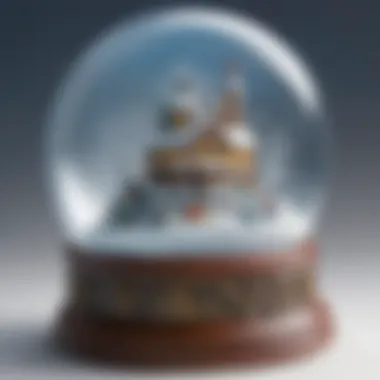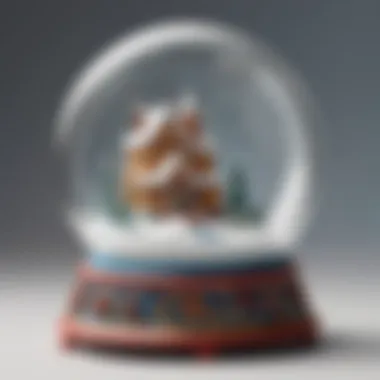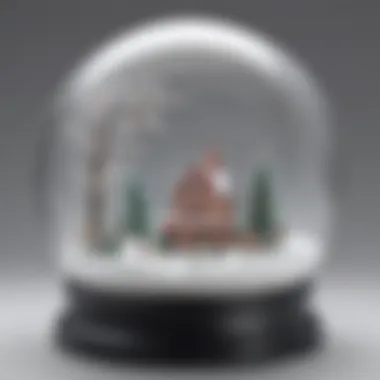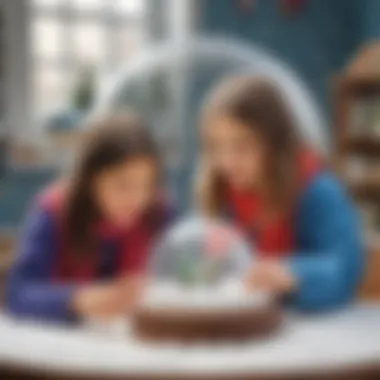Create Unique Snow Globes: A Fun Crafting Guide


Intro
Creating a personalized snow globe can be an exciting project for young enthusiasts, combining craft and science. Making your own snow globe allows you to express creativity while understanding important scientific concepts like density and buoyancy. This guide will help you navigate the journey of designing a unique snow globe from start to finish.
Science Fun Facts
Snow globes are not just decorative items but also fascinating tools to learn about science. Here are a few intriguing facts related to snow globes and the science behind them:
- Buoyancy: The snow inside the globe floats because it is less dense than the liquid surrounding it. Understanding buoyancy plays a significant role in how objects behave in various mediums.
- History: The first snow globe was created in the 19th century as a way to create miniature scenes of winter wonderlands, often used as gifts during the holiday season.
- Incorporation of tiny particles: The "snow" used in snow globes can vary. Some use glitter, while others may use small foam pieces. These materials behave differently in the liquid, showcasing the principles of density.
Did You Know? Snow globes can contain all sorts of decorations, from holiday scenes to personalized figures, making each globe a unique creation.
Understanding these fun facts can enhance your appreciation of the snow globe you design, adding a layer of knowledge to the artistic process.
Discover the Wonders of Science
Engaging in the creation of snow globes can uncover various scientific concepts. Let’s explore some educational aspects:
- Density: As mentioned, density determines which objects float or sink. This principle is crucial when designing your globe. Experimenting with different materials can help illustrate this.
- Liquid Resistance: The movement of the snow particles as they are shaken highlights the viscosity of the liquid inside. Thicker liquids slow down the descent of the snow.
- Real-World Applications: Understanding fluid dynamics through creating snow globes can be linked to various fields like engineering and environmental science.
Educational videos and animations are readily available to visualize these concepts better. Platforms such as Britannica provide resources that can help explain these scientific principles.
Science Experiment Showcase
You can turn the snow globe-making process into a mini experiment. Here’s how:
Fun and Engaging Experiments
- Material Selection: Use different liquids—water, glycerin, or corn syrup—to see which best holds the snow.
- Snow particles: Test various materials to represent snow and observe how each behaves in the liquid.
Step-by-Step Instructions
- Choose Your Globe: Start with a clear jar or glass ornament as your container.
- Select Your Scene: Pick figurines or decorations that will go inside.
- Prepare the Liquid: Decide on your liquid base and combine it with any coloring or glitter.
- Assemble: Place the scene inside the globe, pour in the liquid, and secure the lid tightly.
Materials List
- Clear jar or ornament
- Figurines/decorations
- Liquid (water, glycerin, corn syrup)
- Glitter or artificial snow
- Waterproof adhesive
Safety Tips and Precautions
- Ensure the lid is sealed tightly to prevent leaks.
- If using sharp objects for decoration, handle with care.
By exploring these aspects, you will not only create an art piece but also engage in practical learning about essential scientific principles.
Preface to Snow Globes
Understanding snow globes is essential in designing your own unique version of this enchanting decorative piece. Snow globes are not just whimsical objects; they hold a rich history and cultural significance that can inspire creativity. This section explores various aspects of snow globes, from their definition to their impact on art and society. By delving into these topics, readers will gain a better appreciation of snow globes and find excitement in the prospect of crafting their own.
Definition and History
A snow globe, also known as a snowdome, is a glass sphere filled with water, glitter, and sometimes small figurines or scenes that create a captivating visual experience when shaken. The concept of this delightful object dates back to the 19th century. The first known snow globe was created in France around 1830, originally as a paperweight. These globes quickly gained popularity and began appearing in various forms across Europe and America.
Over time, different designs and themes emerged, ranging from holiday scenes to iconic landmarks. Snow globes have evolved in their complexity and style, becoming beloved collectibles. They represent nostalgia and sentiment, often reminding individuals of cherished memories or special places. Understanding this history allows one to appreciate the artistry and craftsmanship involved in creating these timeless items.
Cultural Significance
Snow globes hold more than aesthetic value; they often symbolize cultural stories and personal connections. Many globes are themed around holidays, such as Christmas or Halloween, making them festive decorations. They are frequently used as gifts, acting as tokens of memory and experience, particularly when personalized.
Different cultures have embraced the snow globe, incorporating local elements. For example, in Japan, snow globes may feature traditional symbols such as cherry blossoms, emphasizing the beauty of nature. In contrast, Western cultures often celebrate seasonal themes or holiday motifs, showcasing their unique traditions.
The significance of snow globes lies in their ability to evoke emotions and memories. They are artifacts that encapsulate moments in time, reminding us of places we have visited or loved ones we have shared experiences with. This emotional connection enhances the value of crafting a custom snow globe, turning it not just into a decorative piece, but a personal treasure.


Understanding the Science Behind Snow Globes
Understanding the science behind snow globes is crucial for grasping how these delightful objects work. By exploring the basic principles of physical science, we can better appreciate both the design and functionality of snow globes. This knowledge not only enhances the creative process but also provides a tangible connection to scientific concepts, making them engaging and relatable for young learners. The interplay between art and science revealed in snow globe creation can inspire curiosity and foster an enjoyable learning atmosphere.
Basic Principles of Buoyancy
Buoyancy is an essential concept in understanding how snow globes operate. At its core, buoyancy is the upward force exerted by a fluid on an object submerged in it. This force allows objects to float or sink, depending on their densities in relation to the liquid. For example, when you shake a snow globe, the flake-like particles represent the snow. They fall slowly through the liquid, which is a demonstration of various forces at work within the globe.
The behavior of these particles is directly tied to their density compared to the water they are suspended in. If a particle is lighter than the liquid, it will rise, while heavier particles will sink. This principle helps to create the enchanting effect we see in a snow globe as the particles swirl and settle. Understanding buoyancy not only adds depth to the snow globe design process but also aids in teaching fundamental physics.
Density and Its Effects
Density, defined as mass per unit volume, plays a pivotal role in how materials behave in a liquid medium. In the context of a snow globe, the density of both the water and the suspended particles influence the visual effect achieved. For example, smaller polymer beads or glitter may behave differently in water than larger plastic or glass pieces.
The choice of materials for the snow globe impacts how it looks when shaken and left still. If the particles are comparable in density to the water, they will move slowly and create a serene, snow-like effect. However, if they are too dense, they may clump together or not move at all. This effect can teach elementary school kids about density and its various implications in real-world scenarios.
As you design your snow globe, consider how buoyancy and density interact. This understanding can lead to unique and intriguing designs that showcase the beauty of science in art.
By applying these scientific principles, anyone creating a snow globe will not only enjoy the process but also gain an invaluable insight into how the world around us works.
Choosing Materials for Your Snow Globe
Choosing the right materials for creating a snow globe is an essential aspect of the design process. The materials not only affect the aesthetics but also play a crucial role in ensuring the functionality and longevity of the finished product. From the type of container to the elements inside, each material contributes to the overall experience of the snow globe. Consideration of these components can elevate a simple craft into a meaningful keepsake or educational tool.
Types of Containers
When selecting a container for your snow globe, you have several options in terms of shape and material. The most common containers are glass or plastic jars. Glass jars offer a classic appearance and a clear view of the internal design, which is often preferred for its visual appeal. On the other hand, plastic jars might be safer, especially for younger children, as they are less likely to break.
Here are some container types to consider:
- Mason Jars: Perfect for creating a traditional snow globe. They come in various sizes and are widely available.
- Wine Glasses: Using a wine glass adds a unique touch and can create a more elegant design.
- Plastic Craft Containers: Ideal for children, these are lightweight and can be found in many shapes and sizes.
Ultimately, the choice of container will depend on the intended use, design, and safety considerations while working on the project.
Selecting Base Elements
The base elements of your snow globe can include figurines, miniature scenes, or personal touches that reflect the theme you want to convey. Choosing elements that resonate with the intended experience is crucial. For instance, if making a winter scene, consider small trees, snowmen, or animals. It is vital to ensure that all items can withstand being submerged in water without deteriorating.
Consider these tips while selecting base elements:
- Size Matters: Ensure that the elements fit well within the chosen container. They should not overcrowd the space.
- Material Compatibility: Should be made from waterproof materials or ones that do not react to water. Plastic and resin figurines are good options.
- Theme Relevance: Choose items that tell a story or convey a specific theme to enhance the narrative of the globe.
Water and Glitter Selection
Water and glitter play fundamental roles in the final appearance of a snow globe. The water must be clear and safe. Distilled water is often the best choice, as it has fewer impurities. Alternatively, adding glycerin helps to slow down the fall of glitter, creating a more mesmerizing effect.
When selecting glitter, choose options that complement the theme of your globe:
- Color: Different colors of glitter can enhance the overall theme. Silver and white are classic choices for snow globes.
- Shape: Some glitters come in various shapes like stars and hearts, adding more charm to your design.
- Amount: A small amount of glitter can create a beautiful effect. It is best to start with less, as overdoing it may cause a visual clutter.
In summary, choosing appropriate materials for your snow globe not only influences its physical appearance but also enhances the overall crafting experience. Focus on quality, compatibility, and creativity when selecting each piece. With careful consideration, your snow globe can transform into a beloved keepsake.
Remember, a thoughtfully designed snow globe can serve as both a decorative piece and a learning tool, captivating the interest of both young and old.
Step-by-Step Guide to Designing a Snow Globe
Creating your own snow globe can be a fulfilling and enjoyable process. This guide provides you with step-by-step instructions on how to design your snow globe, integrating both practical and creative elements. By following this guide, you'll experience the satisfaction of transforming simple materials into a unique piece of art that captures a special moment or theme. The steps outlined below are designed to help you focus on each aspect of the design, resulting in a more personal and completed creation.
Preparing Your Workspace
Before diving into your snow globe project, it is essential to prepare your workspace. A clean, organized environment not only enhances your efficiency but also ensures safety during the crafting process.
- Choose a Suitable Area: Find a flat surface, like a table, that is well-lit and free of distractions. An area where you can spread out your materials will yield better results.
- Gather Materials: Here are the basic materials you will need for your snow globe:
- Protect the Surface: Use newspaper or an old cloth to prevent any mess on your workspace. This precaution makes the cleanup easier.
- Wear Protective Gear: If you are working with sharp tools or hot glue, consider using safety goggles and gloves. This adds an extra layer of safety while you create your globe.


- A glass or plastic container with a tight lid
- Water
- Clear glycerin (optional, for better snow effect)
- Glitter or artificial snow
- Decorative elements like small figurines or photos
- Adhesive (like hot glue)
Assembling Your Snow Globe
Once your workspace is ready, assembling the snow globe itself is the next step. This phase is all about combining your chosen elements effectively. Here’s how to assemble your globe:
- Create Your Scene: Take the small figurines or elements you want to include. Position them inside the lid of the container to visualize how they will look once assembled. You can glue them in place to avoid movement later.
- Prepare the Fluid Mixture: Fill the container with water, leaving some space at the top. Adding a little clear glycerin helps the glitter to float more elegantly when you shake the globe.
- Add Glitter or Snow: Sprinkle a desirable amount of glitter or artificial snow into the water. The key is to find a balance; too much can overwhelm your design.
- Seal the Globe: Carefully place the lid onto the container, ensuring no water leaks out. This step is crucial in preventing any spills and keeping your design intact.
Sealing the Globe
Now that you have your snow globe assembled, securing it is vital for ensuring longevity. This will prevent any accidental spills or leaks. Here's how to effectively seal your snow globe:
- Check for Leaks: Before sealing, make sure everything is as you want it. Look for any water drips or movement from your decorative elements.
- Adhere the Lid: Using a strong adhesive like hot glue, apply a ring around the edge of the lid before placing it on the container. This will create a watertight seal.
- Dry Time: Allow the glue to dry completely. This step can take some time depending on the adhesive used, so be patient.
- Final Inspection: Once dry, inspect your globe again. Shake it gently to test the snow effect and ensure the lid is secure.
"Completing a snow globe is not just about crafting; it’s about encapsulating a memory or theme in a tangible way."
By following these steps, your snow globe will be well-constructed and ready to display. Embrace your creativity and take pride in designing a piece that is entirely your own.
Creative Customization Ideas
Customization plays a vital role in the art of snow globe making. It transforms a simple decorative item into a personal expression of art and meaning. Engaging in the process of designing your own snow globe can benefit the designer in several ways. It enhances creativity and ingenuity. Furthermore, it allows individuals to reflect their interests and stories within the globe. Consider these points when aiming to create a unique piece:
- Personal Connection: Customization fosters a stronger emotional connection to the art, making it more meaningful.
- Creativity Boost: Exploring different themes and ideas inspires creativity.
- Learning Experience: Customizing elements teaches about design choices, materials, and spatial organization.
Theme Selection
Selecting a theme is the first step to customizing your snow globe. A theme sets the tone and context for the entire project. It can represent anything; from a favorite holiday, a cherished memory, to a simple natural scene. Here are some popular themes to consider:
- Seasonal: Popular seasonal themes might include snowy winter scenes, festive celebrations, or spring florals.
- Specific Places: Recreate your favorite destination, such as a beach or a cityscape.
- Interests and Hobbies: Showcase favorite activities, like sports, music, or art.
When choosing a theme, think about how it represents your interests or experiences. Choose something that brings joy and resonates with you or the intended recipient of the globe.
Personalized Messages
Incorporating personalized messages can add a distinct touch to the snow globe. This could be a special phrase, name, or date that holds significance. Adding text can enhance the visual appeal and emotional resonance of the design. Consider the following:
- Text Style: Use different fonts or hand lettering for a unique feel.
- Placement: Position the text elements so that they complement the visual theme.
- Material Choices: Explore using stickers, printed paper, or even engraved elements for longevity.
"Personalized messages encapsulate memories in ways simple images cannot."
Personalizing with text can make the snow globe gift-worthy or memorable keepsakes.
Using Natural Elements
Integrating natural elements into your snow globe is another exciting customization approach. Natural materials not only enhance the visual appeal but also connect the art to its surroundings. Here are some ideas:
- Stones: Use small rocks or crystals to add weight and a touch of nature.
- Flowers: Dried flowers can create a whimsical atmosphere or accent your theme.
- Twigs and Leaves: Incorporate these elements for a rustic or outdoor feel.
When selecting natural elements, consider their size and durability in water. Some organic materials may break down or change in appearance over time. This process can provide new dimensions to the aesthetics of your snow globe.
Exploring Educational Aspects
Designing your own snow globe is not just a fun creative project; it also offers significant educational value. This process integrates art and science and encourages a hands-on learning approach that is vital for young learners. Students can explore scientific principles like density and buoyancy while expressing creativity. This engagement fosters critical thinking and problem-solving skills.
Science Experiments with Snow Globes
One of the key educational aspects of snow globe design is the ability to conduct science experiments. When creating a snow globe, children can directly observe principles of buoyancy and density. By switching the materials inside—such as different types of water or varying the amount of glitter—they can see how these changes affect the final product.
Key Experiments to Try:
- Density Comparisons: Use liquids of varying densities. For example, mix water with corn syrup or oil. Observe how different substances interact in the globe.
- Buoyancy Tests: Experiment with different objects like small toys or natural elements. After adding them to the globe, see which items float or sink and discuss the reasons behind their behaviors.
- Color Experiments: Add food coloring to other liquids in the globe. Observe how colors blend and change, providing a visual representation of how solutions can change chemically.
Children can document their findings, promoting scientific inquiry and reinforcing the importance of observation and analysis.


Integrating Art and Science
The act of creating a snow globe transcends mere crafting; it is an intersection of artistic vision and scientific understanding. This integration enhances learning experiences by showing that science is not always rigid and can include creativity.
Approaches to Merging Art and Science:
- Design Planning: Before starting, encourage kids to sketch their snow globes. They can plan the theme, elements, and overall look, strengthening their artistic skills.
- Color Theory Application: Discuss the color wheel and how it can be applied to choose colors for their snow globe. Understanding complementary colors can enhance aesthetics while illustrating principles of color mixing.
- Reflect on Impact: After making their globes, children can reflect on how the chosen materials and design affect the functionality of their globes. This reflection builds analytical skills and connects the dots between artistic choices and scientific results.
"Art and science are not separate; they both aim to communicate and understand the world around us."
Creating personalized snow globes aids in mastering fundamental concepts while allowing for self-expression. Through this project, students can engage both sides of their brain, fostering a balanced approach to learning.
Maintaining Your Snow Globe
Maintaining your snow globe is crucial for two primary reasons: preservation of its aesthetic appeal and safeguarding its internal components. Over time, dust, grime, or other impurities may accumulate in the globe, obscuring the view of the enchanting scenes you created. Regular maintenance not only enhances its visual appeal but also prolongs its lifespan. Moreover, small issues can arise, and addressing them promptly will ensure that your snow globe remains a cherished keepsake.
Cleaning Tips
Cleaning a snow globe requires care to ensure that the delicate elements inside are not disturbed. Here are some steps to follow:
- Gentle Dusting: Begin by dusting the outer surface with a soft microfiber cloth. Avoid using harsh chemicals or abrasive materials that might scratch the surface.
- Emptying the Globe: If possible, carefully empty the globe. This allows for thorough cleaning inside. Ensure that you remember how everything goes back together.
- Using Warm Soapy Water: For cleaning the interior, use a mix of warm water and mild dish soap. Dip a soft cloth or sponge into the solution, wring it out so it is damp and not wet, then gently wipe down the inside of the glass.
- Rinse and Dry: Rinse with plain water and dry all the components—both the globe and the base—before reassembling to prevent moisture buildup.
- Avoid Harsh Chemicals: Sticking to mild soap is best. Harsh chemicals can damage the glue holding elements together.
"The key to maintaining beauty is regular attention—so don’t ignore your snow globe!"
Repairing Common Issues
Over the years, snow globes may face several common challenges. Being prepared can help you tackle these problems effectively:
- Leaking Water: If you notice any leaking, inspect the glue seal where the globe meets the base. You may need to reapply waterproof glue to prevent further leaks.
- Cloudy Liquid: If the water has turned dull or cloudy, consider replacing it. Empty the globe carefully, clean it, and refill with clear distilled water to maintain clarity.
- Stuck or Missing Characters: If figurines or elements inside the globe are stuck or missing, check if they are still adjoined correctly. You might need tweezers or a small tool to readjust their positions.
- Base Deterioration: Regularly check the base for signs of wear. If it is made of wood or another organic material, consider treating it with furniture polish to maintain luster and protect against moisture.
- Component Replacement: For any broken parts, look for replacement pieces online. Craft stores or specialty shops may carry suitable elements to help you restore your globe.
By keeping these practices in mind, you can ensure that your snow globe remains a beautiful and lasting work of art.
Sharing Your Creation
Sharing your creation is an essential part of the snow globe making process. It allows you to celebrate your achievement while engaging with others who share similar interests. Documenting your journey and the final product not only helps you reflect on your creativity but also inspires others.
Documenting Your Process
Keeping a record of your snow globe creation process can be very rewarding. As you assemble and customize your globe, take photos or notes at each step. This can include the materials you used, the methods you implemented, and any challenges you faced. Consider maintaining a journal or creating a digital photo album. These documentation efforts serve several purposes:
- Reflection: Reviewing your process later helps you recognize your growth and improvement as a creator.
- Guidance: Your documentation serves as a useful guide for others who may want to create their own snow globes. It can include tips and tricks that you found helpful.
- Celebration: Showcasing your work can be gratifying. It’s a way to celebrate the time and effort you put into making your snow globe.
Engaging with the Community
Getting involved with the community can enhance your experience of creating snow globes. There are many platforms online and in person where you can share your designs. Participating in forums like Reddit or joining Facebook groups related to crafts and snow globe making fosters connections with other creators.
Engaging with others can lead to:
- Feedback: Receiving constructive criticism helps you improve your skills and discover new techniques.
- Inspiration: Seeing the work of others can spark new ideas for your projects.
- Collaboration: You might find opportunities to work with others on joint projects, enriching your creative experience.
Sharing your creativity bridges connections and opens opportunities for growth, inspiration, and fun within the crafting community.
The End
Understanding the process of designing your own snow globe encompasses much more than crafting a decorative item. It invites individuals to engage deeply with both artistic creativity and fundamental scientific concepts. As we have explored, each element, from the selection of materials to the final assembly, plays a critical role in the overall outcome of the project. Snow globes serve as not only a personal touch to interior decoration but also a fascinating intersection between art and science.
Recap of Main Points
In this article, we have discussed several key aspects:
- Importance of Personalization: Personalizing a snow globe allows for a unique expression of memory and sentiment. Each design tells a story, making it significantly more intimate than a commercially produced item.
- Scientific Principles: Engaging with concepts like buoyancy and density enriches the learning experience. Understanding how these principles affect the snow globe’s operation adds an educational layer to the crafting process.
- Material Selection: The choice of materials is fundamental, influencing both the aesthetic appeal and functionality. From containers to fillers, each decision shapes the final product.
- Maintenance and Sharing: Knowing how to maintain and repair a snow globe ensures its longevity, while sharing creations within the community fosters connection and inspiration among creators.
Future Exploration
As you contemplate further exploration into the realm of snow globes, consider the following avenues:
- Experiment with New Themes: Explore different themes beyond seasonal designs. Consider historical events or beloved books, thereby integrating personal passions into the creations.
- Expand Educational Opportunities: Utilize snow globe projects in educational settings. This can engage students in science-related discussions, reinforcing concepts of physics and even environmental science with natural elements.
- Incorporate Technology: Think about integrating technology with traditional crafting techniques. Using augmented reality apps can further enhance the experience, providing interactive features that were not possible before.
The journey of designing your own snow globe not only enriches personal creativity but also opens doors to valuable educational discussions. So, whether you are crafting for a sentimental purpose or a scientific inquiry, the benefits are manifold.







